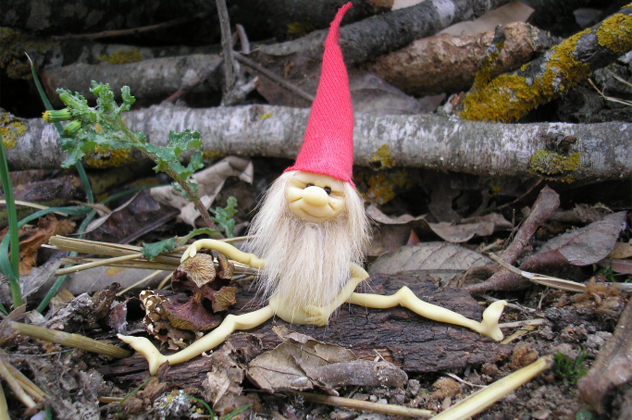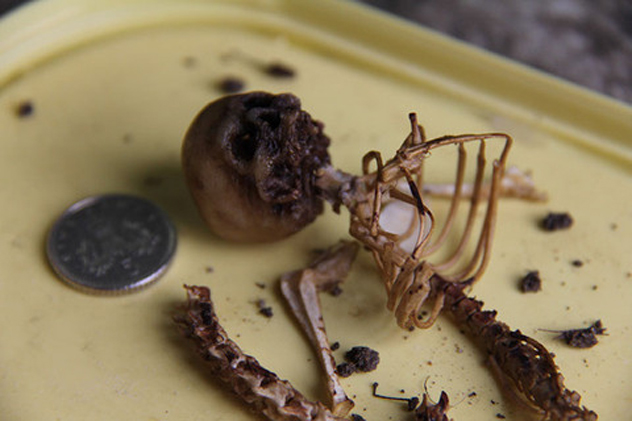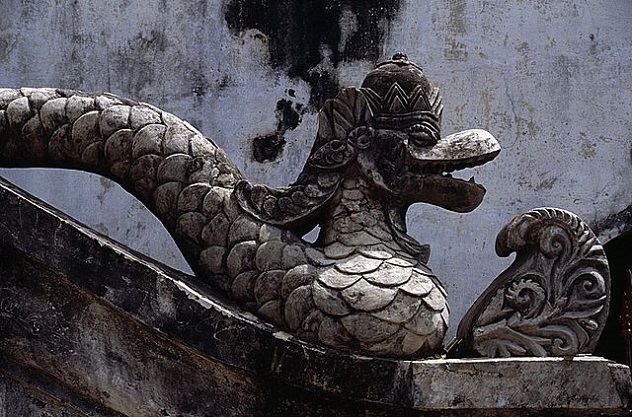 Creepy
Creepy  Creepy
Creepy  Technology
Technology 10 Scientific Breakthroughs of 2025 That’ll Change Everything
 Our World
Our World 10 Ways Icelandic Culture Makes Other Countries Look Boring
 Misconceptions
Misconceptions 10 Common Misconceptions About the Victorian Era
 Mysteries
Mysteries 10 Strange Unexplained Mysteries of 2025
 Miscellaneous
Miscellaneous 10 of History’s Most Bell-Ringing Finishing Moves
 History
History 10 Great Escapes That Ended Right Back in Captivity
 Weird Stuff
Weird Stuff 10 Fascinating Things You Might Not Know About Spiders
 Food
Food 10 Everyday Foods You Didn’t Know Were Invented by the U.S. Military
 History
History 10 Odd Things Colonial Americans Kept at Home
 Creepy
Creepy 10 More Representations of Death from Myth, Legend, and Folktale
 Technology
Technology 10 Scientific Breakthroughs of 2025 That’ll Change Everything
 Our World
Our World 10 Ways Icelandic Culture Makes Other Countries Look Boring
Who's Behind Listverse?

Jamie Frater
Head Editor
Jamie founded Listverse due to an insatiable desire to share fascinating, obscure, and bizarre facts. He has been a guest speaker on numerous national radio and television stations and is a five time published author.
More About Us Misconceptions
Misconceptions 10 Common Misconceptions About the Victorian Era
 Mysteries
Mysteries 10 Strange Unexplained Mysteries of 2025
 Miscellaneous
Miscellaneous 10 of History’s Most Bell-Ringing Finishing Moves
 History
History 10 Great Escapes That Ended Right Back in Captivity
 Weird Stuff
Weird Stuff 10 Fascinating Things You Might Not Know About Spiders
 Food
Food 10 Everyday Foods You Didn’t Know Were Invented by the U.S. Military
 History
History 10 Odd Things Colonial Americans Kept at Home
10 Modern Encounters With Mythological Creatures
Forget UFOs. Stories of sightings of creatures from folklore and legend are rife on the Internet and social media throughout the world. Here are 10 alleged modern encounters with mythological beings.
10Recognition Of The Wyrm
We have talked before about the pervasive belief in elves in Iceland, where concerns over the habitats of these invisible people have affected highway construction. But elves aren’t the only mythological creatures enjoying official recognition in the country. Lake Lagarfljot near Egilsstadir in eastern Iceland is home to Lagarfljotsormurinn, a legendary sea serpent or wyrm monster that has been the subject of folk tales since the 14th century.
In 2012, a YouTube video of a mysterious shape moving in a strange manner beneath the ice became an Internet sensation, with many believing that it was definitive proof of the ancient creature. Finnish researcher Miisa McKeown disagreed, analyzing the video and using screen captures to prove that the apparently moving body was actually stationary in the water and was probably nothing more than an icy fishing net or piece of cloth.
The local government, however, formed a truth commission to determine whether the footage was real, and if the maker of the video was entitled to a $4,000 payout which the council had offered for proof of the beast. Seven out of 13 members of the panel ruled that the footage was real. This was surely the result of sober-minded consideration of the facts, and nothing to do with the local tourism industry.
9The Mermaids Of Kiryat Yam
Locals and tourists alike in the Israeli town of Kiryat Yam have reported sightings of a mermaid, which eyewitnesses report resembles a mixture of a young girl and a dolphin. Once sighted, the creature performs acrobatic tricks for stunned onlookers before disappearing beneath the waves. The town has encouraged the stories, which have been good for the local tourist economy, and the local council has even offered a cash prize of $1 million to anyone who gets photographic evidence of the aquatic humanoid.
In 2010, an NBC investigative team spent a week filming along the beaches of Kiryat Yam. The crew claimed that they spotted the mermaid at night but were unable to track it after it dove out of sight. Hoax videos of the supposed mermaid have gone viral several times over the years. One of the most notorious showed her basking on a rock, but it turned out to be a faked scene made for an Animal Planet mockumentary.
8Dragons Over China
Two students at Jilin University in China were walking out of a library in August 2014 when one of them suddenly spotted something. The other student quickly captured the strange phenomenon on his cell phone camera, later describing it as a 10-meter-long (33 ft) red flying creature with four legs and a tail. It was allegedly flying at a high altitude and radiated a low metallic light that increased in intensity before it vanished into the southeast.
In the past, Chinese dragons have reportedly turned up on news broadcasts, security camera footage, and even as far away as a Buddhist temple in Penang, Malaysia. In 2004, an amateur photographer on the way to attend the opening ceremony of the Qinghai-to-Xizang railroad in Tibet’s Amdo region captured images from an airplane window of two long, scaled creatures flying above the Himalayas.
7Zimbabwe’s Goblin Crisis

Goblins are a problem of increasing concern in Zimbabwe. In 2012, schoolgirls from the St. Sebastian Secondary School in Bulawayo fled screaming after they were allegedly attacked in their classrooms by goblins resembling dwarves that transformed into baboons. These evil spirits are known as zvikwambo in the Shona language and are believed to be only visible to those whom they attack. Apparently, vicious mermaids frightening workers sent to install water pumps on reservoirs have also been identified as zvikwambo. These goblins have been accused of everything from invading marital beds and demanding sexual favors to attacking nurses and the police.
Even politicians have not escaped association with the little troublemakers. A local businessman named Isau Mupfumi was forced to defend himself against accusations of using goblins to entice people to purchase his goods. Workers at Mupfumi’s head office discovered a “goblin” resembling a snake in a bottle full of human blood, and an alleged photo of Mupfumi’s goblin went viral among Zimbabweans on Facebook and WhatsApp. For his part, Mupfumi has denied everything and claimed that the accusations originate from rivals jealous of his land acquisitions: “I am a devoted Christian and I am not into goblins. It is sad that for every successful deed there are always people who are determined to bring you down.”
6The Falcon’s Nest Pixie Skeleton

In March 2015, a UK-based alternative arts podcast received some strange photos from a listener in Cornwall. The photos appeared to show a tiny, partial humanoid skeleton, including a skull, rib cage, and spine. The anonymous listener allegedly worked for a bird rescue center, and one of his jobs was inspecting the nests of endangered birds to check breeding numbers and prevent the theft of rare eggs by collectors. During one such routine check in a falcon’s nest, he discovered the weird bones hidden among twigs and feathers and collected them in a sample bag.
He assumed them to be the remains of a Cornish pixie. Afraid that he’d be ridiculed anywhere else, he sent the photographs to the podcast to get their perspective on the find. Suspiciously, one of the podcast’s hosts, Dan Baines, was responsible for the 2007 mummified fairy hoax in Ireland, but has long since recanted and has stated that while he believes in fairies, he thinks they are spirit entities rather than flesh-and-blood creatures. As for the Cornwall discovery, he admits to being baffled.
5The Taniwha On Google Earth

In late 2014, New Zealand engineer Pita Witehira was using Google Earth to view the area around Oke Bay on New Zealand’s North Island when he spotted something unusual. Witehira, who owns property on the bay, was viewing satellite images to plan the building of a beach chalet when he spotted what he believed was the wake of a giant sea creature of Maori legend. He told the Daily Mail: “The Native Maori would call this a taniwha as it appears not to be a whale and it is far too big to be a shark. It is moving too fast and turning too sharply to be a whale.”
He dismissed the idea that it was the wake of a recreational boat, as there was no characteristic white foam that would be expected from a motor. Experts analyzing the images dismissed his claims, saying that a lack of white foam in the wake would not be unusual for a small recreational boat about 5 meters (16 ft) long, with one researcher claiming that the photo would be consistent with a catamaran traveling at seven knots.
Taniwha, which are dragon-like guardian spirits of Maori legend, have turned up in the Kiwi media before. In 2011, a spat erupted between the Auckland City Council and the Ngati Whatua tribe over a planned railway tunnel through an area believed to be inhabited by one of the elusive creatures. An advocate for Maori interests asked the council what was being done to protect the taniwha, leading a disgruntled councilor to complain that the advocate was “letting off the T-Bomb.”
4The Alabama Leprechaun
In 2006, a camera crew from local television station WPMI descended on Le Cren Street near UMS-Wright in Mobile, Alabama, to investigate crowds massing in the area. Some members of the crowd soon told reporters that people had sighted a leprechaun hiding in a nearby tree. An amateur sketch of the diminutive Irish creature was produced, and this likeness in combination with colorful interviews with local residents helped to make the report an early viral video on then-new YouTube.
Some believe the story was merely a prank played by the residents at the expense of the news crew, and some, including the O’Reilly Factor, suggested that the popularity of the video played off racial prejudices. A followup investigation by AL.com in March 2015 featured an interview with a man who claimed to have been the first to see the leprechaun. He described the appearance of the creature as being a “metamorphosis,” with the mouth or nose appearing first, followed by the rest of the face. Since the infamous report, he has tweeted about sighting the leprechaun several times, reporting 70 percent visibility on one occasion in 2010.
3The Naga Protests

Protests erupted in the village of Baan Kan Sai in northeast Thailand after a local man named Sayan Chomkamsingha discovered an object while fishing in a pond near his house in April 2015. It was a bronze figurine of a naga, a snake-like creature from Buddhist cosmology, but Sayan claimed that when he first discovered it, the object was slimy and wriggling, only turning to bronze when it came in contact with the air.
Police confiscated the figurine in order to deliver it to the Department of Fine Arts to determine its historical value but were surrounded by a jeering mob of 300 faithful pilgrims who believed the object to be the actual body of a naga. The police managed to get the figurine into a van after some negotiations, but the angry mob tried to break its windows. The Department of Fine Arts determined that the object was less than 30 years old and returned it to the undoubtedly embarrassed police, and they released it to Sayan when a 100-strong crowd of pilgrims protested in front of police headquarters. While the police suspect Sayan of defrauding the pilgrims, he maintains that the figurine represents the genuine remains of a naga.
2The Djinn Divorce

In 2014, a man in the United Arab Emirates was granted the right to divorce his wife after he discovered that she was possessed by a supernatural spirit known as a djinn. This supposed possession apparently manifested itself in the wife’s refusal to have sex with him. She then told him to discuss the matter with her family, who told him that religious scholars had failed several times to exorcise the spirit. The Dubai Sharia Court granted the man the divorce and ordered him to pay alimony of $11,000, which was later repealed because the woman hadn’t been honest about the djinn possession.
Belief in djinn spirits originated with pre-Islamic Arabian mythology, and today it still exists in immigrant populations in the West. Ahmed Al-Khatib of Manchester, accused of murdering his wife, pleaded not guilty to murder charges on mental health grounds. He claimed to have seen his wife in the form of a terrifying djinn, which made him push her away. She died when she hit her head on a piece of furniture. One witness claimed that he had earlier said of his wife: “She is not a woman, I will kill her.” Frankly, if anyone was possessed by a djinn it was probably Al-Khatib himself, who later freaked out in the middle of the courtroom, grabbed an interpreter by the neck, and shoved him against the wall.
1Aswang Attacks

Of the many tales of monsters in Filipino folklore, the one with the strongest influence in the modern world is that of the aswang, a shape-shifting, blood-drinking creature that preys on humans and animals at night. It has ill-defined features and powers: Some say it can transform into a pig or dog, others that it can separate the front half of its body and fly around, and still others that it has a long tongue to suck unborn babies from their mothers’ wombs.
In 2014, an anonymous text message caused panic: “WARNING: To everyone in Batangas, don’t loiter around at night. A group of aswang riding a big truck from CAPIS CAM SUR is already in Sto. Tomas. Don’t trust anyone you don’t know. This is not a joke. From: POLICE Tanauan.” The local police denied any such report and believe the whole story to be a hoax. But belief in the creature has also led to tragedy. In 2014, a 70-year-old woman in Bacolod City was beheaded by her own son when he became convinced that she was an aswang.
The previous year in the same city, a drunk man beat his neighbor to death believing that he was a cannibalistic aswang, and in 2013 a man hacked his mute daughter and sent her into critical condition at a hospital in a case of apparent aswang mistaken identity. It just goes to show that mythological monsters can’t hold a candle to vicious human stupidity.
Are you a mythological creature? David Tormsen wants to hear from you. Send proof of your corporeal existence to [email protected]. (No weirdos.)








